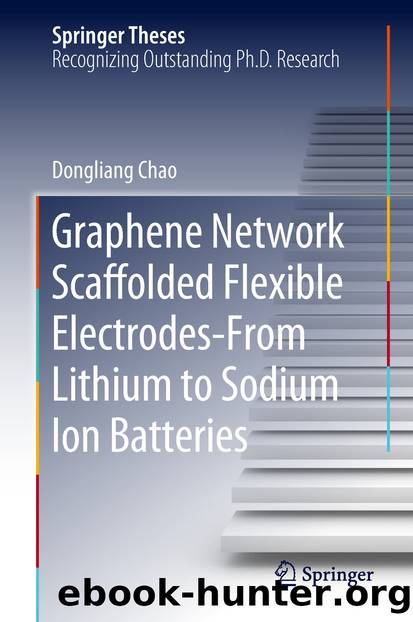Graphene Network Scaffolded Flexible Electrodes-From Lithium to Sodium Ion Batteries by Dongliang Chao

Author:Dongliang Chao
Language: eng
Format: epub
ISBN: 9789811330803
Publisher: Springer Singapore
3.2.2 Preparation of VO2@GQD Arrays
150 mg graphene oxide (GO, by a modified Hummers method) was dispersed in 20 mL DMF (under ultrasonication for 30 min). The solution was transferred into a 30 mL Teflon-lined stainless steel autoclave and heated at 200 °C for 8 h. After being cooled down naturally, the mixture was filtered using a 0.22 μm microporous membrane and the obtained brown solution was functional GQDs dispersion in DMF. The solvent of suspension was removed with the aid of a rotary evaporator at 80 °C under reduced pressure. VO2@GQD arrays can be obtained in the help of a facile electrophoresis process by dispersing the functional GQD in DI water. The above GF supported VO2 arrays were used as the substrate (working electrode) for the growth of VO2@GQD arrays, and Pt plate was used as counter electrode. And then a positive potential of 6 V for different time in the condition of ice-bath was applied to deposit functional GQDs onto the surface of VO2 arrays. Finally, the samples were annealed at 400 °C in Ar for 2 h to obtain good structure stability. As a comparison, VO2@GQD arrays were also fabricated on transparent conductive fluorine-tin-oxide (FTO) substrates using the same methods as described above. The weight increase (measured by an analytical balance, RADWAG, MYA 21, d = 1 µg) after GQDs deposition was ca. 30 µg (ca. 5% weight of VO2 arrays).
Download
This site does not store any files on its server. We only index and link to content provided by other sites. Please contact the content providers to delete copyright contents if any and email us, we'll remove relevant links or contents immediately.
| Automotive | Engineering |
| Transportation |
Whiskies Galore by Ian Buxton(41529)
Introduction to Aircraft Design (Cambridge Aerospace Series) by John P. Fielding(32888)
Small Unmanned Fixed-wing Aircraft Design by Andrew J. Keane Andras Sobester James P. Scanlan & András Sóbester & James P. Scanlan(32573)
Craft Beer for the Homebrewer by Michael Agnew(17933)
Turbulence by E. J. Noyes(7700)
The Complete Stick Figure Physics Tutorials by Allen Sarah(7138)
Kaplan MCAT General Chemistry Review by Kaplan(6595)
The Thirst by Nesbo Jo(6436)
Bad Blood by John Carreyrou(6274)
Modelling of Convective Heat and Mass Transfer in Rotating Flows by Igor V. Shevchuk(6222)
Learning SQL by Alan Beaulieu(6035)
Weapons of Math Destruction by Cathy O'Neil(5829)
Man-made Catastrophes and Risk Information Concealment by Dmitry Chernov & Didier Sornette(5646)
Digital Minimalism by Cal Newport;(5389)
Life 3.0: Being Human in the Age of Artificial Intelligence by Tegmark Max(5184)
iGen by Jean M. Twenge(5161)
Secrets of Antigravity Propulsion: Tesla, UFOs, and Classified Aerospace Technology by Ph.D. Paul A. Laviolette(4990)
Design of Trajectory Optimization Approach for Space Maneuver Vehicle Skip Entry Problems by Runqi Chai & Al Savvaris & Antonios Tsourdos & Senchun Chai(4839)
Electronic Devices & Circuits by Jacob Millman & Christos C. Halkias(4748)
